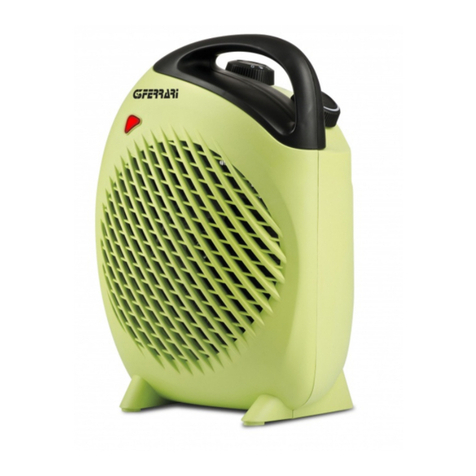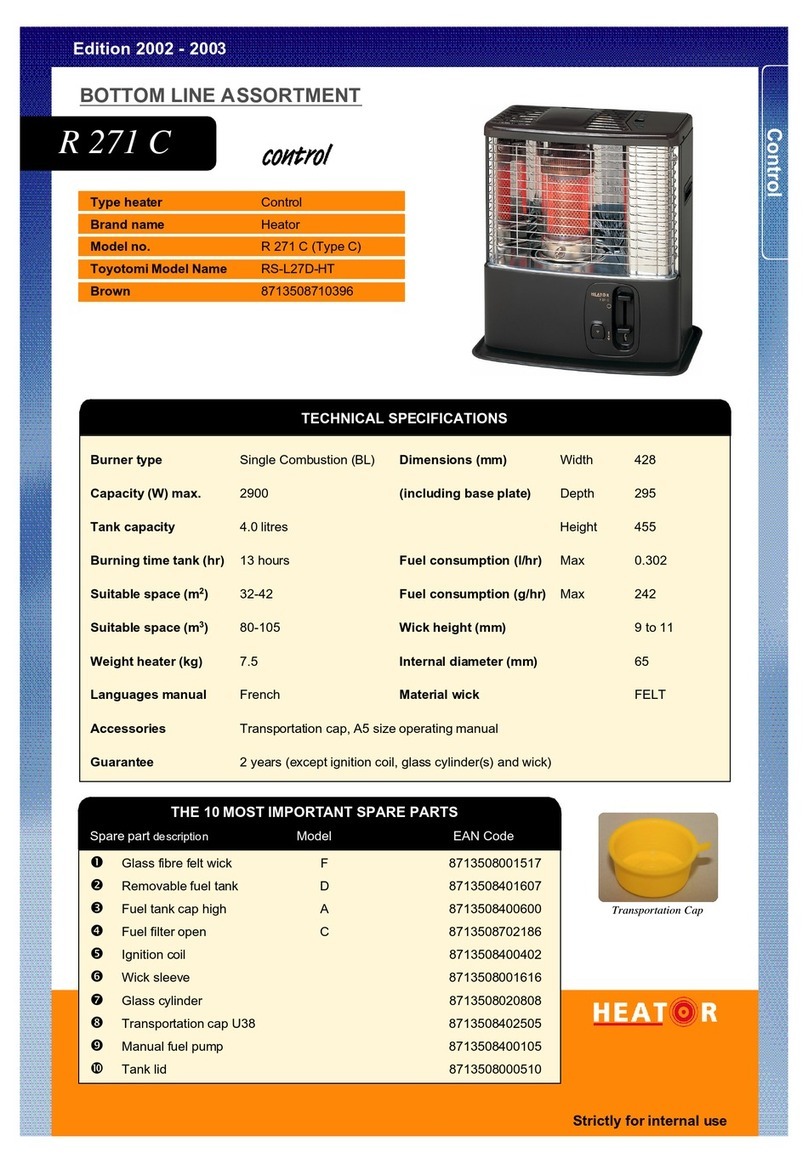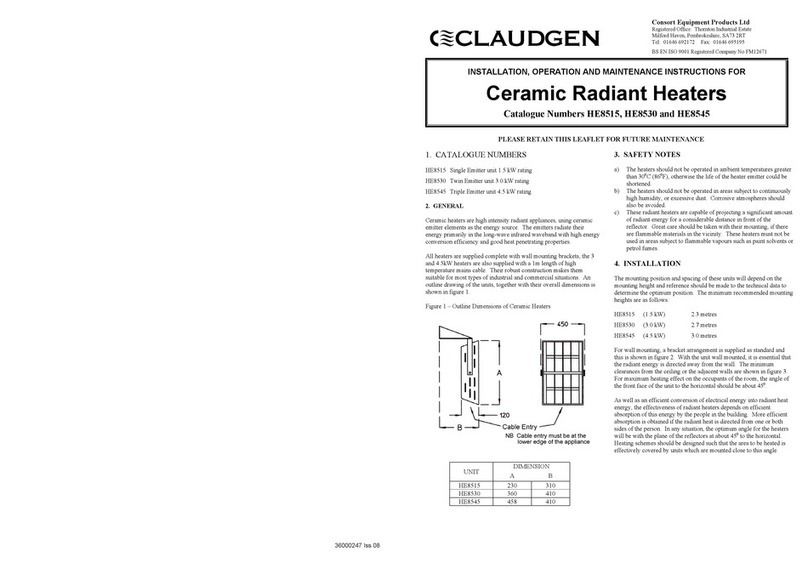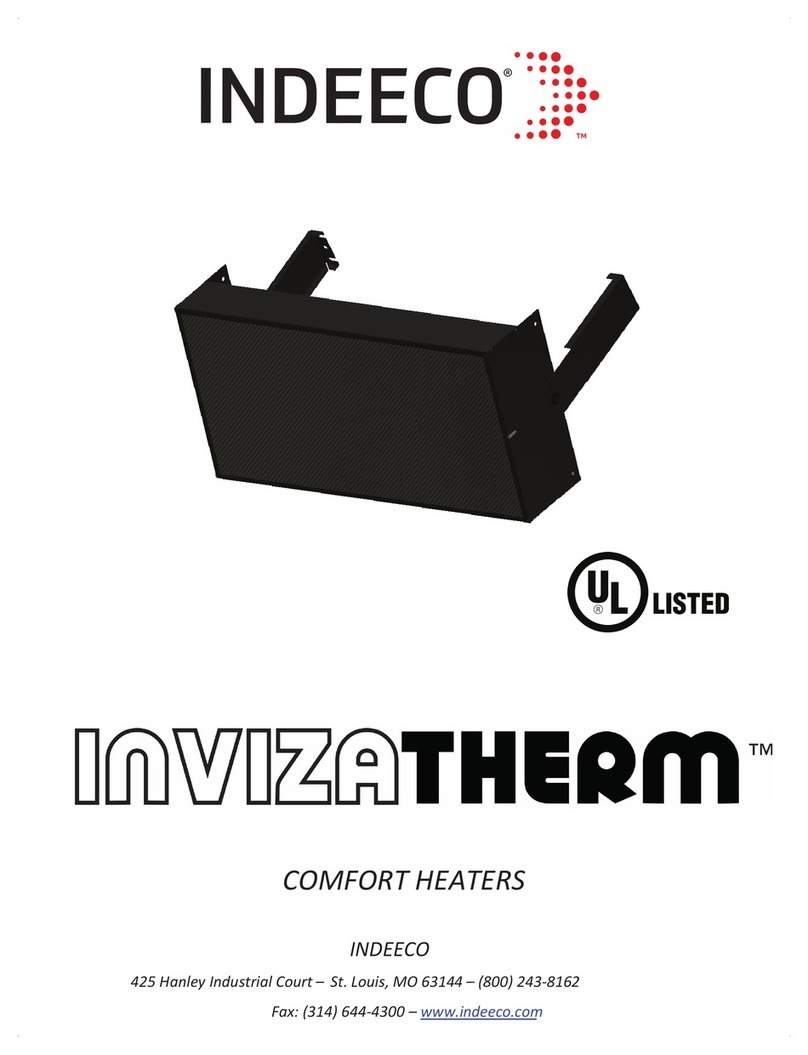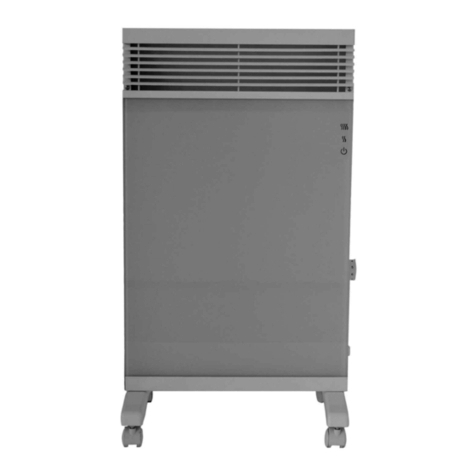Charmglow F500070 User manual

1
FOR USE ONLY WITH DECORATIVE TYPE
UNVENTED ROOM HEATERS.
Do not store or use gasoline or other flammable
vapors or liquids in the vicinity of this or any other
appliance.
WHAT TO DO IF YOU SMELL GAS
• DO NOT light any appliance.
• DO NOT touch any electrical switches.
• DO NOT use any phone in your building.
• Immediately call your gas supplier from a neighbor’s
phone.
Follow your gas suppliers instructions.
• If your gas supplier cannot be reached, call the fire
department.
Installation and service must be performed by a
qualified installer, service agency or the gas supplier.
WARNING: IF THE INFORMATION IN THIS MANUAL
IS NOT FOLLOWED EXACTLY, A FIRE OR
EXPLOSION MAY RESULT CAUSING PROPERTY
DAMAGE, PERSONAL INJURY OR LOSS OF LIFE.
PLASMA
MODEL : F500070
UNVENTED WALL MOUNTED ROOM HEATER
INSTALLATION INSTRUCTIONS
(Para Instrucciones en español, ver la página 12)
Installer And Consumer Are
To Retain The Appliance
Manual With The Installed
Appliance
WARNING: IMPROPER INSTALLATION, ADJUSTMENT,
ALTERATION, SERVICE OR MAINTENANCE CAN CAUSE
INJURY OR PROPERTY DAMAGE. REFER TO THIS
MANUAL. FOR ASSISTANCE OR ADDITIONAL
INFORMATION CONSULT A QUALIFIED INSTALLER,
SERVICE AGENCY OR THE GAS SUPPLIER.
WARNING: DO NOT BUILD A WOOD FIRE. DO NOT
BURN WOOD OR OTHER MATERIAL IN THESE
APPLIANCES.
This is an unvented gas-fired heater. It uses air
(oxygen) from the room in which it is installed.
Provisions for adequate combustion and ventilation air
must be provided. Refer to Combustion and Ventilation
Air Section, Page 3.
This appliance may be installed in an aftermarket,
permanently located, manufactured (mobile) home,
where not prohibited by local codes.
The appliance is only for use with the type of gas
indicated on the rating plate. This appliance is not
convertible for use with other gases.
Issue E-15/06
INSTALLER:
LEAVE THIS MANUAL WITH THE APPLIANCE.
CONSUMER:
RETAIN THIS MANUAL FOR FUTURE REFERENCE.
Due to high temperatures, the appliance should be
located out of traffic and away from furniture or
draperies. Do not place clothing or other materials on or
near this appliance.

This appliance is a high efficiency, unvented, flame effect gas heater. It
provides radiant and convected warmth both efficiently and safely
utilizing the latest type catalytic convertor burner technology. The
appliance does not require a flue system of any type as the catalytic
converter cleans the flue products to provide a complete combustion
system, which is intrinsically safe.
These heaters are fitted with a specially designed pilot utilizing an
oxygen depletion sensor (ODS) which responds to the amount of
oxygen available in the room and shuts the heater off before the oxygen
level drops below 18%. The pilot can be relit only when fresh air is
available. Refer to the Combustion and Ventilation Air section.
The appliance is designed to fit various types of situations as listed in
the Installation Requirements.
This appliance is factory set for operation on the gas type, and at the
pressure stated on the appliance rating plate.
On initial light up of a new appliance, the ‘newness’ will burn off within
the first few hours of operation. During this period some smoke may be
emitted from outlet grille, this should be no cause for concern.
Accordingly, the room should be well ventilated with all windows and
doors open during this period.
Read all these instructions before commencing installation.
All instructions must be handed to the user for safekeeping.
QUANTITY DESCRIPTION
1 Firebox and burner assembly
1 Installation and operating instructions
1 Decorative frame assembly
1 Screw and wall plug pack
1 Wall mounting plate
1 Rubber grommet
1 Fitting template
STATE OF MASSACHUSETTS: THE INSTALLATION MUST BE MADE
BY A LICENSED PLUMBER OR GAS FITTER IN THE
COMMONWEALTH OF MASSACHUSETTS.
Carbon Monoxide Poisoning: Early signs of carbon monoxide
poisoning are similar to the flu with headaches, dizziness and/or
nausea. If you have these signs, obtain fresh air immediately. Turn off
the gas supply to the appliance and have it serviced by a qualified
professional, as it may not be operating correctly.
2
Section Contents Page No.
1.0 General Information 2
2.0 Inventory 2
3.0 Appliance Data 2
4.0 Important Safety Information 2
5.0 Codes 3
6.0 Combustion and Ventilation Air 3
7.0 Site Requirements 4
8.0 Preparing the Appliance 5
9.0 Mounting the Appliance 5
10.0 Checking the Burner 6
11.0 Final Fitting of the Frame Assembly 6
12.0 Connecting a Gas Line 6
13.0 Checking the Gas Connections 6
14.0 Gas Pressure Check 6
15.0 Spark Gap 7
16.0 Briefing the customer 7
17.0 Servicing 7
18.0 Servicing the Burner 7
19.0 Pilot Assembly 8
20.0 Catalysts 8
21.0 Testing for Firebox Leakage 8
22.0 Cleaning 8
23.0 Lighting Instructions 9
24.0 To Turn off gas to Appliance 9
25.0 Troubleshooting Guide 10
26.0 Shortlist of Spare Parts 10
27.0 Positioning of field assembled parts 11
WARNING: FAILURE TO COMPLY WITH THE INSTALLATION
AND OPERATING INSTRUCTIONS PROVIDED IN THIS
DOCUMENT WILL RESULT IN AN IMPROPERLY INSTALLED
AND OPERATING APPLIANCE, VOIDING ITS WARRANTY.
ANY CHANGE TO THIS APPLIANCE AND/OR ITS
OPERATING CONTROLS IS DANGEROUS. IMPROPER
INSTALLATION OR USE OF THIS APPLIANCE CAN CAUSE
SERIOUS INJURY OR DEATH FROM FIRE, BURNS,
EXPLOSION OR CARBON MONOXIDE POISONING.
1.0 GENERAL INFORMATION
2.0 INVENTORY
4.0 IMPORTANT SAFETY INFORMATION
TABLE OF CONTENTS
3.0 APPLIANCE DATA
Gas Type Natural Gas
Gas inlet pressure Maximum 10.5” w.c.
Minimum 6” w.c.
Regulator Pressure Setting 5” w.c.
Max Energy Input 8,870 BTU/hour
Min Energy Input 5,110 BTU/hour
Pilot Energy Input 560 BTU/hour
Burner (Manifold) Pressure High 3.6” w.c. (+/-0.3” w.c.) Hot
3.5” w.c. (+/-0.3” w.c.) Cold
Low 1.2” w.c. (+/-0.3” w.c.) Hot
1.1” w.c. (+/-0.3” w.c.) Cold
Main burner flow restrictor Stereo 1.45mm (1/4” BSP)
Oxypilot SIT/Bray 9082
Gas Inlet Connection 3/8” NPT at regulator
Ignition Piezo spark
Spark Gap 1/8” - 3/16”
Please see Data Plate affixed to appliance for current data.
This appliance is for use only with the gas type, and at the pressure
stated on the appliance Data Plate.
IMPORTANT: READ AND UNDERSTAND THESE
INSTRUCTIONS COMPLETELY BEFORE INSTALLING OR
OPERATING YOUR UNVENTED ROOM HEATER.
WARNING: FAILURE TO KEEP THE PRIMARY AIR
OPENING(S) OF THE BURNER(S) CLEAN MAY RESULT IN
SOOTING AND PROPERTY DAMAGE.

• Children and adults should be alerted to the hazard of high surface
temperature and should stay away to avoid burns or clothing ignition.
• Young children should be carefully supervised when they are in the
same room with the heater.
• Do not place clothing or other flammable material on or near the
heater.
• Any safety screen or guard removed for servicing the heater must be
replaced prior to operating the heater.
• Installation and repair should be done by a qualified service person.
The heater should be inspected before use and at least annually by a
professional service person. More frequent cleaning may be required
due to excessive lint from carpeting, bedding material, etc. It is
important that control compartments, burners and circulating air
passageways of the heater be kept clean.
• Allow the heater to cool before servicing. Always shut off the gas to
the heater while performing service work.
• The installation must conform with local codes or, in the absence of
local codes with the National Fuel Gas Code, ANSI Z223.1.
• The heater and its individual shut-off valve must be disconnected
from the gas supply piping system while performing any tests of the
gas supply piping system at pressures in excess of 1/2 psig.
• The heater must be isolated from the gas supply piping system by
closing its individual manual shut-off valve during any pressure
testing of the gas supply piping system at test pressures equal to or
less than 1/2 psig.
• Keep heater area clear and free from combustible materials, gasoline
and other flammable vapors and liquids.
• Do not use this heater if any part has been under water. Immediately
call a qualified service technician to inspect the room heater and to
replace any part of the control system and any gas control which has
been under water.
• Input ratings are shown in BTU per hour and are for elevations up to
4,800 feet. Do not install this heater at an elevation above 4,800 feet if
the gas supply has not been derated for that elevation. Consult your
local gas supplier. (For operation at elevations above 4,800 feet,
equipment ratings shall be reduced at the rate of 4 percent for each
1,000 feet above sea level before selecting appropriately sized
equipment.)
• Ensure that the heater is clean when operating. Excessive dust
accumulation on the burner will increase the amount of carbon
monoxide formation and could lead to carbon monoxide poisoning
and/or death.
• This appliance is intended for supplemental heating
Adhere to all local codes or in their absence the latest edition of The
National Fuel Gas Code ANSI Z223.1 or NFPA54 which can be obtained
from The American National Standards Institute, Inc. (1430 Broadway, New
York, NY, 10018) or National Fire Protection Association, Inc.
(Batterymarch Park, Quincy, MA, 02269).
Seller of unvented propane or natural gas fired supplemental room heaters
shall provide to each purchaser a copy of 527 CMR 30 upon sale of the
unit.
This Focal Point Unvented Gas Room Heater is certified by OMNI-Test
Laboratories, Inc to ANSI Z21.11.2-2004b standard.
This heater shall not be installed in a confined space or unusually tight
construction unless provisions are provided for adequate combustion and
ventilation air.
The National Fuel Gas Code, ANSI Z223.1/NFPA 54 defines a confined
space as a space whose volume is less than 50 ft 3per 1,000 BTU/Hr (4.8
m3per kW) of the aggregate input rating of all appliances installed in that
space and an unconfined space as a space whose volume is not less than
50 ft 3per 1,000 BTU/Hr (4.8 m3per kW) of the aggregate input rating of all
appliances installed in that space.
Rooms communicating directly with the space in which the appliances are
installed, through openings not furnished with doors, are considered a part
of the unconfined space.
Unusually tight construction is defined as construction where:
a. wall and ceilings exposed to the outside atmosphere have a continuous
water vapor retarder with a rating of one perm or less with openings
gasketed or sealed, and
b. weather stripping has been added on operable windows and doors, and
c. caulking or sealants are applied to areas such as joints around window
and door frames, between sole plates and floors, between wallceiling joints,
between wall panels, at penetrations for plumbing, electrical, and gas lines,
and at other openings.
Use the following equations to determine if you have a confined or
unconfined space.
3
5.0 CODES
6.0 COMBUSTION AND VENTILATION AIR4.0 IMPORTANT SAFETY INFORMATION (continued)
Determine the volume of space — ft 3.
Length x Width x Height = _____ ft 3
(Include adjoining rooms with doorless passageways or ventilation
grills between rooms.)
Example: 24' (L) x 16' (W) x 8' (H) = 3072 ft 3
Divide the volume of space by 50 ft 3to determine the maximum
BTU/Hr the space can support.
______ (volume of space – ft 3)/ 50 ft 3=
(Maximum BTU/Hr the space can support)
Example: 3072 ft 3 / 50 ft 3 = 61.44
or 61,440 BTU/Hr the space can support.
Add the BTU/Hr of all the fuel burning appliances in the space.
Vent-Free heater _______ BTU/Hr
Gas appliance #1* _______ BTU/Hr
Gas appliance #2 + _______ BTU/Hr
Gas appliance #3 + _______ BTU/Hr
Total = _______ BTU/Hr
Example: Vent-free heater #1 9,000 BTU/Hr
Vent-free heater #2 23,000 BTU/Hr
Gas appliance #1 35,000 BTU/Hr
(water heater) Total = 67,000 BTU/Hr
* Do not include direct-vent gas appliances. Direct-vent is sealed
combustion and draws combustion air from the outdoors.
1.
2.
3.

The space in the previous example is a confined space because the actual
BTU/Hr used is more than the maximum BTU/Hr the space can support.
You must provide additional fresh air.
Your options are:
a. Rework equations adding the space of adjoining room(s). If the extra
volume provides an unconfined space, then remove door or add ventilation
grills between rooms. Refer to National Fuel Gas Code, ANSI Z223.1,
Section 5.3.
b.
Vent room directly to the outdoors. Refer to National Fuel Gas Code,
ANSI Z223.1, Section 5.3.
c. Install a lower BTU/Hr heater to make the area an unconfined space.
If the actual BTU/Hr used is less than the maximum BTU/Hr the space can
support, then the space is an unconfined space. You will need no additional
fresh air ventilation for an unconfined space.
This appliance is designed to be wall-hung. Do not recess any part
of the appliance into the wall.
This Appliance may be installed in any room in a home except Bathrooms
- or areas where large amounts of steam are likely to be generated.
Installation in living rooms is common, however other rooms such as
kitchens, dining rooms and hallways are permitted, providing a suitable
natural gas supply is available, and rooms sizing and ventilation
requirements are strictly adhered to (see section 6.0).
The appliance is designed to be versatile, and as such will operate correctly
when exposed to normal gentle draughts experienced within the home. It is
not recommended, however that the appliance be installed in areas where
it is likely to be exposed to persistent strong draughts, that may be
generated by outside doors or windows, air vents etc. It is recommended
that the appliance should not be installed within 20” of any air vent.
Clearances to non-combustibles
Non-combustible surfaces are defined as brick, metal, marble, concrete
etc. and also a number of man-made materials impervious to flame. If in
doubt refer to the material manufacturer for further information before
proceeding with installation.
Clearances to the sides of the appliance are 4”. Clearance to the front of
the appliance is 20”.
The back of the appliance may be installed directly onto a non-combustible
wall, providing the area behind the appliance is flat and does not interfere
with the various vent holes in the back panel of the appliance.
The appliance may be installed with or without a non-combustible hearth. If
a hearth is fitted, the size and design may be as desired.
A non-combustible shelf of any depth may be positioned above the
appliance provided it is no closer than 16” from the top of the appliance
glass panel and the wall above the appliance is non combustible.
Clearances to combustible materials
Combustible materials are defined as wood, fabrics, or other materials
likely to combust if exposed to flame. Generally, any material, which is likely
to discolour, melt or misshape when exposed to moderate heat, should be
considered as a combustible material or surface.
Clearance to the sides of the appliance are 4” but curtains, drapes and
other fabrics are not permitted within a distance of 20” of the appliance
sides. No such materials are permitted directly above the appliance
regardless of distance.
The minimum clearance to the ceiling above the appliance is 32” measured
from the top of the appliance glass panel.
Combustible materials should not be positioned directly in front of the
appliance within a distance of 40”.
Under no circumstances should any electrical equipment e.g. plasma
screen TV sets etc. be positioned on the wall above the appliance. The
appliance is designed to be wall mounted alone and not in conjunction with
any type of combustible fire surround. No combustible shelves should be
positioned on the wall above the appliance. It should be established that
any mirrors or picture frames etc. to be positioned on the wall above the
appliance are able to withstand prolonged exposure to moderate heat and
moisture before proceeding with their installation.
The back of the appliance may be installed directly onto a combustible wall,
providing it is relatively flat and does not interfere with the various vent
holes in the back panel of the appliance. The wall must be structurally
sound and constructed from a material capable of withstanding moderate
heat. Finished plaster, conventional wall paper and dry-lined plasterboard
are examples of suitable materials. Materials such as flock, blown vinyl and
embossed paper which are sensitive to even small amounts of heat should
be avoided as scorching and or discoloration may occur over time.
If the appliance is to be mounted on a dry-lined wall or a timber framed
construction wall then the integrity and ability of the wall to carry the weight
of the appliance must be confirmed. It is important in these circumstances
that any vapor control barrier is not damaged, and that any structural
members of the house frame are not damaged.
The appliance may be positioned as close to a solid floor (i.e. stone,
wooden laminate etc.) as the particular design of fire frame permits,
however it is not permitted to install the appliance within 4” of carpet, rugs
or fabric materials of any kind. This dimension is measured vertically to the
bottom of the appliance frame.
4
6.0 COMBUSTION AND VENTILATION AIR - continued
WARNING: IF THE AREA IN WHICH THE HEATER MAY BE
OPERATED IS SMALLER THAN THAT DEFINED AS AN
UNCONFINED SPACE OR IF THE BUILDING IS OF
UNUSUALLY TIGHT CONSTRUCTION, PROVIDE ADEQUATE
COMBUSTION AND VENTILATION AIR BY ONE OF THE
METHODS DESCRIBED IN THE NATIONAL FUEL GAS CODE,
ANSI Z223.1/NFPA 54, SECTION 5.3 OR APPLICABLE LOCAL
CODES.
7.0 SITE REQUIREMENTS
4.
Compare the maximum BTU/Hr the space can support with the
actual amount of BTU/Hr used.
_______ BTU/Hr (max. the space can support)
_______ BTU/Hr (actual amount of BTU/Hr used)
Example:
61,440 BTU/Hr (max. the space can support)
67,000 BTU/Hr (actual amount of BTU/Hr used)
WARNING: DO NOT USE A BLOWER INSERT, HEAT
EXCHANGER INSERT OR OTHER ACCESSORY NOT
APPROVED FOR USE WITH THIS HEATER.

5
The appliance must be prepared for
installation by removing the front
decorative frame, removing the selected
gas inlet ‘knock-out’, and assembling and
fitting the rear frame to the appliance.
These steps are carried out as follows:
1. The decorative fire frame assembly
comprises of three parts, the front frame,
the rear frame and the outlet grille.
Remove the front frame retaining screws
(positions shown in figure 1) from the side
of the firebox and carefully remove the
front frame from the appliance. Remove
the wall mouting plate from the appliance
by removal of the two wingnuts located in
the lower inner secion of the firebox.
2. Gas connection :
The heater gas inlet
connection is 3/8” NPT at the regulator,
located below the burner, in the right
hand side of the heater.
There are four
possible entry points for the gas supply pipework to enter the appliance
firebox. These entry points are ‘knock out’ type holes (shown in figure 2).
Non-concealed gas connections may be made using the entry points at
either end of the firebox or the one in the bottom of the firebox. A concealed
gas connection may be made using the knock out hole in the centre back
of the firebox. Select
the most appropriate
entry point and knock
out the relevant hole.
If a concealed gas con-
nection is to be made,
the supply pipe should
always be sleeved
through walls and
floors using the
shortest possible route.
For concealed supply
pipe routing, pipes
must (where possible) be vertical and providing there is sufficient wall thick-
ness available, they should be placed in pipe chases. Horizontal pipe runs
should be avoided. Prior to chasing a solid wall, an inspection should be
made to note the proximity of any cables/sockets outlets which may already
be buried. Pipes must be secured using suitable clips and protected against
corrosion. Ideally factory finished protected pipework and fittings should be
used. Joints should be kept to a minimum and compression fittings must
not be used. The pipework installation must be tested for soundness before
any protection is applied and/or the pipework and fittings are buried.
Now it i
s necessary to
assemble the rear frame
of the appliance. Unpack
the four frame sections
and lay face down on a
soft surface taking care
not to damage the painted
finish. Using the eight self
tapping screws provided,
fasten the frame pieces
together as shown in fig-
ure 3, making sure that
the edges align neatly.
With the rear frame
assembled, and the
main firebox lying
with the glass panel
downwards, attach
the rear frame to the
main firebox using
four self tapping
screws in the
positions shown in
figure 4.
After having
selected the
final mounting
position of the
appliance, tak-
ing into account
the site
requirements as
specified in
section 7 of
these
instructions, the
integrity of the
wall, and the
feasibility of the
proposed
supply pipe
routing, the appliance firebox may be secured to the wall.
A full size fitting template is supplied to assist with wall mounting.
If the heater is to be installed on a studded wall with conventional 16”
stud spacing then a wall mounting plate is supplied to enable this. First
locate the studs and using suitable fixings, screw the mounting plate to
the wall via the four mounting holes. The heater may then be hung onto
the mounting plate. The bottom of the heater may be secured onto the
lower mounting studs using the wingnuts or the hex nuts provided.
Mark the positions shown as “Plasma/Capella/Radium fixing points on
the wall. If the appliance is to be mounted on the inner leaf of a con-
ventional cavity wall, or a solid wall, drill four holes using a 1/4” masonry
bit. Insert the fiber wall plugs provided.
If the appliance is to be mounted on a dry lined wall or a timber framed
construction wall then special cavity screw fixings will be required which
are not supplied with this product. These should be constructed from
metal and not plastic.
If a concealed gas connection is to be made ensure the gas supply pipe
is in it’s final position and can enter the appliance in the correct position
when the appliance is hung on the wall.
Insert the wall mounting screws into the top wall plugs, taking care to
leave the screws protruding approximately 3/8” from the wall. Now hang
the appliance onto these screws through the two keyhole shaped holes
in the back panel of the appliance.
8.0 PREPARING THE APPLIANCE
9.0 MOUNTING THE APPLIANCE
13.8 (350mm)
FIREBOX OUTLINE
CONTORNO DE LA
CAMARA DE
COMBUSTION
PLASMA/ CAPELL A
RADIUM
CENTRE LINE
FOCAL POINT
WALL MOUNTED
CATALYTIC VENT FREE
GAS FIRE RANGE
FITTING TEMPLATE
DO NOT RECESS OR
INSET ANY PART OF
THE FIRE.
0.5 (13mm)
FOCAL POINT
PLANTILLA PARA LA
INSTALACION DE LA
GAMA DE CHIMENEAS
DE GAS CATALITICAS
DE PARED SIN SALIDA
DE HUMOS
NO EMPOTRE NINGUN
ELEMENTO DE ESTA
CHIMENEA
LINEA DE
CENTRO
POSITION SPIRIT LEVEL ALONG THIS EDGE TO LEVEL TEMPLATE BEFORE MARKING OUT WALL
REFLECTION, ATHOS, NEON, SCANDIUM
AND PLASMA / RADIUM
MOUNTING PLATE
PLACA DE MONTAJE
F860033 ISSUE A - 24/4/06
WALL MOUNTED VENT FREE
FITTING TEMPLATE
PLANTILLA PARA LA
INSTALACION DE
CHIMENEAS DE PARED SIN
SALIDA DE HUMOS
IMPORTANT
THIS FIRE IS TO BE WALL HUNG ONLY. DO NOT RECESSOR INSET ANY PART OF THE FIRE.
THIS TEMPLATE IS FOR THE MARKINGOF FIXINGPOINTS ONLY. DO NOT INSTALL THE FIRE WITHTHIS TEMPLATE IN PLACE.
IMPORTANTE
ESTE APARATO UNICAMENTE DEBE SER COLGADO EN UNA PARED. NO EMPOTRE NINGUN ELEMENTO DEESTA CHIMENEA.
ESTA PLANTILLA SIRVE UNICAMENTE PARA MARCAR LOSPUNTOS DE FIJACION. RETIRE LA PLANTILLA ANTES DE COLOCAR LA CHIMENEA.
PIERCE TEMPLATE
TO MARK HOLE
POSITION
ON WALL X 4
(ALL MODELS)
PERFORE LA
PLANTILLA PARA
MARCAR LA POSICION
DE LOS4 TALADROS
EN LA PARED
(TODOS LOS MODELOS)
FIXING POINTS:
PUNTOS DE SUJECION:
PLASMA, CAPELLA, RADIUM
WHEN MOUNTING PLATE IS NOT USED
SI NO SE UTILIZA LA PLACA DE MONTAJE
CONCEALED GAS INLET
(ALL MODELS)
ENTRADA DE GAS OCULTA
(TODOS LOS MODELOS)
COLOQUE EL NIVEL SOBRE ESTE BORDE PARA NIVELAR LA PLANTILLA ANTES DE MARCAR LA PARED
16 (406mm)
CONCEALED GAS INLET
ENTRADA DE GAS OCULTA
REFLECTION, ATHOS,
NEON, SCANDIUM
17.2 (437mm)
18 (457mm)
"
"
"
"
"
WARNING: DO NOT ALLOW FANS TO BLOW DIRECTLY
INTO THE FIREPLACE. AVOID ANY DRAFTS THAT ALTER
BURNER FLAME PATTERNS.
Figure 1
Figure 2
Figure 3
Figure 4
Figure 5

Insert the lower
mounting screws
into the lower wall
plugs through the
corresponding
depressed holes in
the lower part of the
back panel. Do not
tighten fully.
Before tightening the
wall mounting screws fully, at this stage it is recommended to check the
horizontal alignment of the appliance with a spirit level, as small adjust-
ments can still be made if necessary. When this has been checked,
tighten all four fixing screws fully.
To access the upper fixing screws insert a screwdriver through the
holes in the deflector plates above the catalyst as shown in figure 6.
There are no imitation fuel bed components to install. The appliance
features a ribbon burner which is designed to produce a continuous
band of flame over its length. The burner should be visually inspected
to ensure it is free from any foreign matter. If it is necessary to clean or
dust off the burner then the glass door should be removed by removal
of the four retaining screws. Re-fit the glass door after cleaning or
inspection, ensuring a good seal.
The front section of the frame assembly should now be re-fitted. Re-
fitting is the reverse of removal as detailed in section 8.0.
A qualified gas appliance installer must connect the gas room heater to
the gas supply.
Consult all local codes. Route gas line using techniques and materials
prescribed by local and/or national codes. Only use pipe of 1/2" or
greater diameter to allow full gas volume to the gas fireplace. Undue
pressure loss will occur if the pipe is too small.
An ANSI approved manual shut-off valve and union must be installed
upstream of the heater within the fireplace cavity when rigid pipe is
used. Ensure that a sediment trap is installed upstream of the heater
(figure 7) within the structure’s piping system to prevent moisture and
contaminants from passing through the pipe to the heater controls and
burner. Failure to do so could prevent the heater from operating reliably.
The heater gas inlet connection is 3/8” NPT at the regulator, located
below the burner, in the right hand side of the heater. When tightening
up the joint to the regulator hold the regulator securely with a wrench to
prevent the regulator from moving.
Turn on gas supply and test for gas leaks using a gas leak test solution
(also referred to as bubble leak solution).
NOTE: using a soapy water solution (50% dish soap, 50% water) is an
effective leak test solution, but it is not recommended, because the
soap residue that is left on the pipes/fittings can result in corrosion over
time.
A. Light the appliance (refer to the lighting instructions label in the con-
trol compartment or on page 9).
B. Brush all joints and connections with the gas leak test solution to
check for leaks. If bubbles are formed, or gas odor is detected, turn the
gas control knob (off/pilot/on) to the “OFF” position. Either tighten or
refasten the leaking connection, then retest as described above.
C. When the gas lines are tested and leak free, be sure to rinse off the
leak testing solution.
D. Observe the individual tongues of flame on the burner. Make sure all
ports are open and producing flame evenly across the burner. If any
ports are blocked, or partially blocked, clean out the ports.
The heater regulator
controls the burner
pressure which
should be checked at
the pressure test
points located on the
control valve itself
(shown in figure 8) for
burner (manifold) and
regulator setting
pressure.
The valve is found on
the centre of the
appliance behind the
valve cover.
6
9.0 MOUNTING THE APPLIANCE - continued
10.0 CHECKING THE BURNER
11.0 FINAL FITTING OF THE FRAME ASSEMBLY
12.0 CONNECTING A GAS LINE
13.0 CHECKING THE GAS CONNECTIONS
IMPORTANT: HOLD HEATER REGULATOR WITH A
WRENCH TO PREVENT MOVEMENT WHEN CONNECTING
TO INLET PIPING.
Figure 6
Figure 7
14.0 GAS PRESSURE CHECK
Burner
(Manifold)
pressure
Regulator
pressure
setting
Figure 8

Remove the valve cover by unscrewing the two retaining screws.
Release the test point screws and ensure operating pressures are with-
in the limits specified in section 3 “Appliance data” on page 2 of these
instructions.
The pressure should be checked with the gas heater burning and the
control set to high flame.
The pressure regulator on manual models is preset and locked to avoid
tampering. If the pressure is not as specified in the Appliance Data sec-
tion on page 2, replace the regulator with P/N FT/F730031 Replace the
test point screws after pressure measurement ensuring no gas leaks.
The gap between the
spark electrode and the
pilot should be 1/8” to
3/16” to produce a good
spark. There should be no
need to adjust this. If under
any circumstances the
piezo electric spark fails,
the pilot cannot be lit
manually.
All instructions must be
handed to the user for safekeeping. Show the customer how to light and
control the fire.
After commissioning the appliance, the customer should be instructed
on the safe use of the appliance and the need for regular servicing.
Frequency of service depends on usage, but MUST be carried out at
least once annually.
Advise that cleaning of the fire may be achieved when the fire is cold
using a damp cloth and mild detergent on most surfaces.
Advise that the fire will emit a "newness" smell for a time after initial
commissioning and that extra ventilation may be needed during this
time. Recommend that a guard be used for the protection of the young,
pets, the elderly and the infirm.
Isolate the fire from the gas supply. Ensure that the fire is fully cold
before attempting service. A suggested procedure for servicing is
detailed as follows;
1. Lay out the dustsheet and tools.
2. Remove the front section of the frame by following section 8.0
3. Remove the glass door assembly (4 screws) and clean
carefully.
4. Inspect the burner and the catalysts and clean if necessary
with a soft brush.
5. Disconnect the gas supply.
6. Undo the four screws retaining the burner support brackets to
the base and rear of the firebox.
7. Remove the burner unit, strip off the burner pipes and clean
thoroughly.
8. Clean the in-line restrictor, pilot assembly and the burner
tube. Do not attempt to remove the pilot injector as this can
cause damage.
9. Re-assemble components.
10. Turn on the gas supply and leak test. Check pilot and
burner for good ignition.
11. Refit the glass door assembly, ensuring a good seal.
12. Refit the casing. Refitting is the reverse of removal as
detailed in section 8.0.
13. Check the purpose provided ventilation is unobstructed.
14. Light the fire and test setting pressures.
15. Check safe operation of the appliance.
For specific servicing instructions, see relevant sections.
First, remove the front section of the frame (as per section 8.0), the
glass panel, and disconnect the gas connection inside appliance. The
gas connections to the gas valve can now be released. Undo the four
screws retaining the burner brackets to the base and rear of the firebox.
The burner may now be removed.
Remove the pilot and main burner pipes and blow through to dislodge
any debris. Now remove the inline restrictor and blow through to make
sure it is entirely clear.
Unclip the pilot lint gauze and clean with a soft brush. Clean the exterior
of the pilot assembly with a soft brush and blow through the flame ports
on the pilot head. Check the aeration holes are free from lint or dirt. The
pilot assembly can be removed if required by disconnecting the
electrode HT lead, gas pipe, thermocouple lead and unscrewing the
mounting screws and lifting away.
7
15.0 SPARK GAP
16.0 BRIEFING THE CUSTOMER
WARNING: DO NOT ADD LOGS OR ORNAMENTS
SUCH AS PINE CONES, VERMICULITE OR ROCK
WOOL. USING THESE ADDED ITEMS CAN CAUSE
SOOTING.
17.0 SERVICING
18.0 SERVICING THE BURNER
Figure 9
Spark gap
WARNING: ANY CHANGE TO THIS HEATER OR ITS
CONTROLS CAN BE DANGEROUS.
14.0 GAS PRESSURE CHECK - continued

The pilot assembly is a non-serviceable item and should not be taken
apart. Aeration holes must be absolutely clear internally for proper
operation. NEVER MODIFY OR BEND THE THERMOCOUPLE TO
MAKE THE PILOT STAY ALIGHT. Modifications are dangerous and can
have serious unseen effects on safety. If the pilot will not stay lit there
is a problem with dirt, the gas supply to it, or the thermocouple needs
replacement.
The gas valve is a non-serviceable item. If this needs replacement,
remove the indicator plate then the securing screw holding the valve
bracket in place, remove all pipe unions, and the complete valve.
Replacement must be original manufacturers parts.
Re-assemble in the reverse of removal. Ensure setting pressures are
as stated in Section 3; Appliance Data.
Remove the casing, glass panel and burner unit (as per servicing sec-
tion), lint arrestor and pilot unit by using a screwdriver to remove the
retaining screws.
Clean the pilot assembly with a soft brush and blow through. Check the
aeration holes are free of any dirt or lint. Clean thoroughly internally,
the connection can be removed from the base of the pilot unit using two
spanners to make cleaning easier. Do not damage or try to dismantle
the pilot injector.
The unit is factory set and the only check necessary is to ensure the
spark gap is correct. See specifications for gas setting.
NEVER MODIFY OR BEND THE THERMOCOUPLE TO MAKE THE
PILOT STAY ALIGHT. If the pilot will not stay lit there is a problem with
dirt, the gas supply, or the thermocouple needs replacement.
Modifications are dangerous and can have a serious unseen effect on
safety and therefore MUST not be done. Replacements must be origi-
nal manufacturers parts. Re-assemble in the reverse of removal.
Ensure setting pressures are as stated in Section 3; Appliance Data.
It is recommended that the catalysts are inspected for signs of damage
and dirt during routine servicing procedures. The expected life of the
catalysts is in excess of 11,000 hours (10 years of normal use). After
this time the catalyst should be replaced.
If there are any deposits of dirt or soot on the catalysts they should be
cleaned with a soft brush and a vacuum cleaner. If removed for cleaning
ensure the seals are in good condition before replacing the catalyst.
New seals will usually be required.
The performance of the catalyst may be checked using a combustion
gas analyzer as follows.
Important: The temperature of the gases emitted by the catalytic
converters is in excess of 700 oF. Measuring gas of this temperature
may damage some types of gas analyzers. If in doubt consult the
equipment manufacturer.
Ignite the fire as per the operating instructions, and run at maximum
setting for 15 minutes. Position gas sample probe directly over a cata-
lyst via the outlet grille, on top of the appliance. Record the carbon diox-
ide (CO2) concentration and then the carbon monoxide (CO)
concentration as displayed by the analyzer - also noting the units in
which the values are expressed. Most analyzers display carbon dioxide
(CO2) concentrations in percentage (%) terms and carbon monoxide
concentration in parts per million (ppm) terms.
In order to calculate the combustion ratio for the appliance (CO/CO2) it
is first necessary to express both gas concentrations in terms of per-
centage. To convert from parts per million (ppm) to a percentage (%)
divide the ppm figure by 10,000. Examples : 35ppm = 0.0035%, 15ppm
= 0.0015%, 5ppm = 0.0005%.
Now divide the concentration of carbon monoxide (CO) expressed in
percent by the concentration of carbon dioxide (CO2) to obtain the
appliance combustion ratio.
The combustion ratio of the gasses emitted by the catalytic convertor
should not exceed 0.0015.
If replacing, firstly, remove the decorative fire frame as described in
section 8.0. The catalysts are located on the top of the internal firebox
and can be removed be unscrewing the retaining nuts securing the
clamping plate. Remove the catalysts and the seals and discard.
Refit a new catalyst and seals in reverse order, ensure the catalyst and
door have a good seals.
Appliances that are several years old or have been extensively disman-
tled should be checked for soundness. It is important that all the prod-
ucts of combustion pass through the catalytic convertors at the top of
the firebox before leaving the appliance.
The firebox is heated by lighting for a few minutes to provide a flow
through the firebox. The burner is then shut off and a smoke pellet or
match introduced at the base of the fire underneath the burner tray.
Large quantities of smoke will emerge from the top of the appliance, but
none should emerge from the joints or gasket faces, especially around
the door. It is important to note that the appliance can never be expect-
ed to be 100% smoke tight and small quantities of smoke may be seen
in corners of joints and gasket faces etc without affecting safety when
the fire is in operation.
GLASS PANEL -This can be cleaned with a suitable glass cleaner, or
proprietary ceramic hob cleaner. Test on a small area first.
PAINTED AREAS - These can be cleaned using a dry cloth.
STAINLESS STEEL AREAS - These can either be cleaned using a
proprietary stainless steel metal cleaner or baby oil. Test on a small hid-
den part of the stainless steel before cleaning. Always clean in the
direction of the grain.
8
18.0 SERVICING THE BURNER - continued
19.0 PILOT ASSEMBLY
20.0 CATALYSTS
CO (%)
CO2 (%) = ratio
21.0 TESTING FOR FIREBOX LEAKAGE
WARNING: NO ADJUSTMENTS ARE TO BE MADE TO
THE ODS PILOT SYSTEM. TAMPERING WITH THIS
SYSTEM CAN BE EXTREMELY HAZARDOUS.
22.0 CLEANING
WARNING: TURN OFF THE UNVENTED GAS ROOM
HEATER AND ALLOW TO COOL BEFORE CLEANING.

FOR YOUR SAFETY READ BEFORE LIGHTING
WARNING: IF YOU DO NOT FOLLOW THESE INSTRUCTIONS EXACTLY, A FIRE OR EXPLOSION MAY
RESULT CAUSING PROPERTY DAMAGE, PERSONAL INJURY OR LOSS OF LIFE.
A. This heater has a pilot which must be lit by hand. When
lighting the pilot, follow these instructions exactly.
B. BEFORE OPERATING smell all around the heater area for gas.
Be sure to smell next to the floor because some gas is
heavier than air and will settle on the floor.
WHAT TO DO IF YOU SMELL GAS
• Do not try to light any appliance.
• Do not touch any electric switch; do not use any phone in
your building.
• Immediately call your gas supplier from a neighbor’s phone.
Follow the gas supplier’s instructions.
• If you cannot reach your gas supplier, call the fire department.
C. Use only your hand to push in or turn the gas control knob.
Never use tools. If the knob will not push in or turn by hand, do
not try to repair it, call a qualified service technician. Forced or
attempted repair may result in a fire or explosion.
D. Do not use this heater if any part has been under water.
Immediately call a qualified service technician to inspect the
appliance and to replace any part of the control system and
any gas control which has been under water.
23.0 LIGHTING INSTRUCTIONS
1. Stop! Read the safety information above.
2. Make sure manual shut-off valve is fully open.
3. Open the control access panel.
4. Depress control knob in and turn clockwise to the
“OFF” position ( Figure 10 ).
5. Wait 5 minutes to clear out any gas. Then smell for gas, including near
the floor. If you smell gas, STOP! Follow the safety instructions in “What
to do if you smell gas” under section ‘B’ above. If you do not smell gas,
go to next step.
6. The pilot is located on the left side behind the burner (Figure 11).
7. Depress control knob in and turn counterclockwise
to the “SPARK” position ( Figure 10 ) and hold there for a few seconds.
Note: If you are running the heater for the first time or after an extended
period of non use it will be necessary to press the control knob all the
way in for 30 seconds to allow air to bleed out of the gas piping.
8. Continue turning counterclockwise through the spark
click to the PILOT light position, ensuring the pilot has lit. If not, turn the
knob fully clockwise, and repeat.
9. Hold the control knob in for a further 10 seconds to prevent the flame
failure detector from shutting off the gas while the probe is warming up.
10. Release the control knob while turning counterclockwise
to the preferred setting. Close the control access panel.
• If the knob does not pop out when released, stop and immediately call
your service technician or gas supplier.
• If the pilot will not stay lit after several tries, depress and turn the gas
control knob clockwise to “OFF”and wait 30 seconds.
Depress and turn knob counterclockwise to “SPARK” and
ignite the heater again. If your pilot does not relight depress and turn
control knob clockwise to “OFF” and call your service
technician or gas supplier.
11. Wait 30 seconds before readjusting the heater when the control knob
has been turned down to a lower setting.
24.0 TO TURN OFF GAS TO APPLIANCE
2. Depress and turn control knob clockwise to the “OFF”
position (Figure 10). Close the control access panel.
1. Open the control access panel.
Figure 10 : Control knob. This is located
behind the lower front panel of the appliance.
Figure 11 :Pilot unit. This is located behind
the burner, on the left-hand side of the
appliance.
Figure 11
Figure 10
9

Fire sparks but pilot does not light No gas to fire, check isolators are open.
Pipe work blockage, clean out.
Air not fully purged, re purge supply or wait longer.
Spark grounding to metal work, reset gap correctly.
Blocked pilot, clean out internally.
Pilot lights but then goes out Severe restriction in gas supply: clear obstruction.
Faulty thermocouple, replace pilot unit.
Blocked pilot, clean out.
Blocked lint gauze, clean.
Hold control knob in for longer.
Check control knob does not foul data plate.
If the pilot will not stay lit there is a problem with dirt, the gas supply, or the thermocouple needs
replacement. Modifications are dangerous and can have a serious unseen effect on safety.
NEVER MODIFY OR BEND THE THERMOCOUPLE TO MAKE THE PILOT STAY ALIGHT.
Fire does not spark at pilot HT lead detached, refit.
Check the spark gap (see section 15.0).
Faulty piezo unit, replace.
Debris shorting out electrode, clean.
Spark shorting to metalwork under tray, realign HT lead.
Fire runs for a time and then cuts off Loose or faulty thermocouple, rectify.
Blocked pilot, clean out.
Dirt or lint in pilot aeration hole or on the lint gauze, clean thoroughly.
If the pilot will not stay lit there is a problem with dirt, the gas supply, or the thermocouple needs
replacement. Modifications are dangerous and can have a serious unseen effect on safety.
NEVER MODIFY OR BEND THE THERMOCOUPLE TO MAKE THE PILOT STAY ALIGHT.
Pilot flame shrinks when fire is on high Poor gas flow to fire, check pressure with fire on high.
If pressure is low, remove any restriction in pipework or valve.
Check all isolators are adequately sized and fully open.
Check meter pressure is adequate.
If the pilot will not stay lit there is a problem with dirt, the gas supply, or the thermocouple needs
replacement. Modifications are dangerous and can have a serious unseen effect on safety.
NEVER MODIFY OR BEND THE THERMOCOUPLE TO MAKE THE PILOT STAY ALIGHT.
Fire smells when first lit or in use Newness smell from brand new appliance.
Leakage occurring. Carry out leakage test and rectify any problems.
Combustible materials used in incorrect positions.
10
25.0 TROUBLESHOOTING GUIDE
26.0 REPLACEMENT PARTS
Description Part number
Glass door assembly FB/F960003
Gas Valve FT003155/0
Catalyst FB/F780079
Pilot unit FT/F730023
Burner unit TRAY051
Seal kit for catalyst IN/F940136
Inlet pressure regulator FT/F730031
Decorative front frame FR/F550097
Decorative rear frame FR/F550098
When ordering spare parts, always give the following information;
1. The model number of the heater.
2. The serial number of the heater.
3. The part number.
4. The description of the part.
5. The quantity required.
6. The installation date of the heater.
If you encounter any problems, require spare parts, or have any
questions concerning the installation of the heater please contact;
Focal Point (North America)
5555 Pleasantdale Road
Doraville, Georgia 30340
Toll free :1 800 704 6093
Fax: 770 368 8261
Manufactured by :
Focal Point Fires plc.
Christchurch, Dorset
United Kingdom BH23 2BT

11
Figure 12
Figure 13
Figure 14
Figure 12 : Removal and refitting of glass
door assembly and burner assembly.
Figure 13 : Removal and refitting of the
decorative front frame assembly.
Figure 14 : Visual check
for correct pilot flame.
denotes 4 off burner fixing points
WARNING: FAILURE TO POSITION
THE PARTS IN ACCORDANCE WITH
THESE DIAGRAMS OR FAILURE TO
USE ONLY PARTS SPECIFICALLY
APPROVED WITH THIS HEATER
MAY RESULT IN PROPERTY
DAMAGE OR PERSONAL INJURY.
As our policy is one of continuous improvement and development , we hope therefore you will understand we must retain the right to amend details and/or specifications without prior notice.DO005558/0
27.0 POSITIONING OF FIELD REMOVABLE PARTS
Table of contents
Popular Heater manuals by other brands
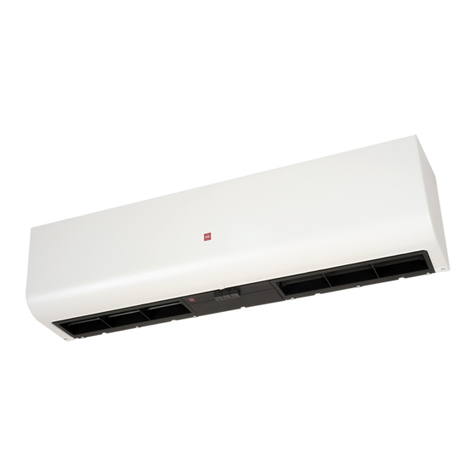
KDK
KDK 2509UA Installation and operating instructions
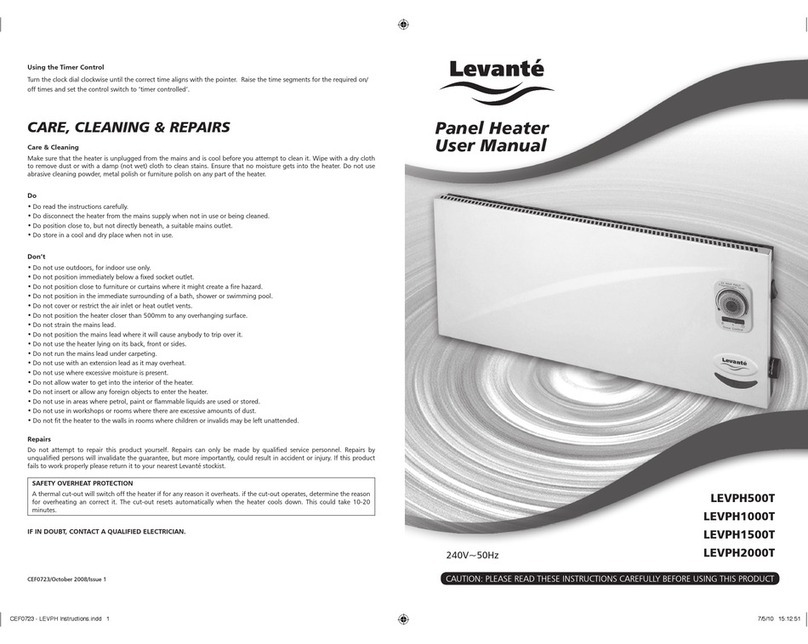
Levante
Levante LEVPH500T user manual

Heat Outdoors
Heat Outdoors 901199C Safety instructions and operation manual
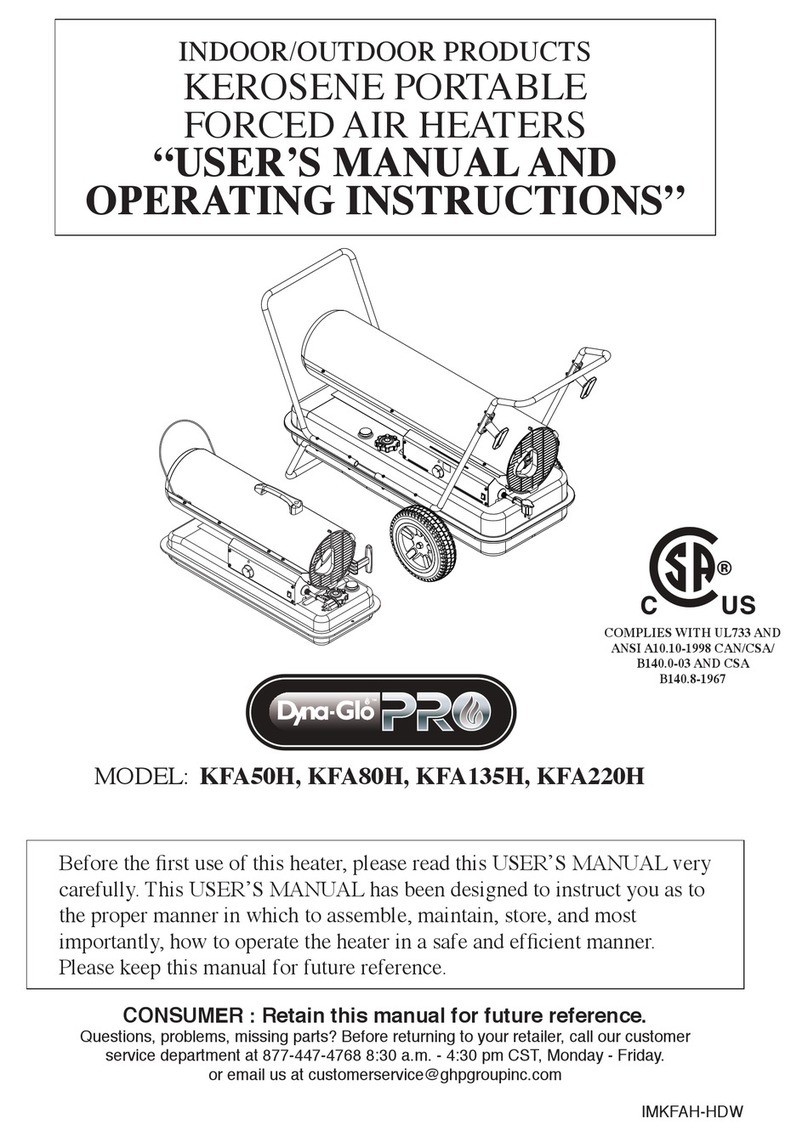
Dyna-Glo
Dyna-Glo KFA80H User's manual and operating instructions
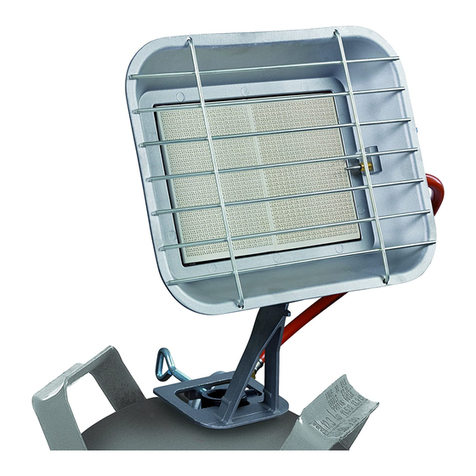
EINHELL
EINHELL GS 4600 Installation and operating instructions
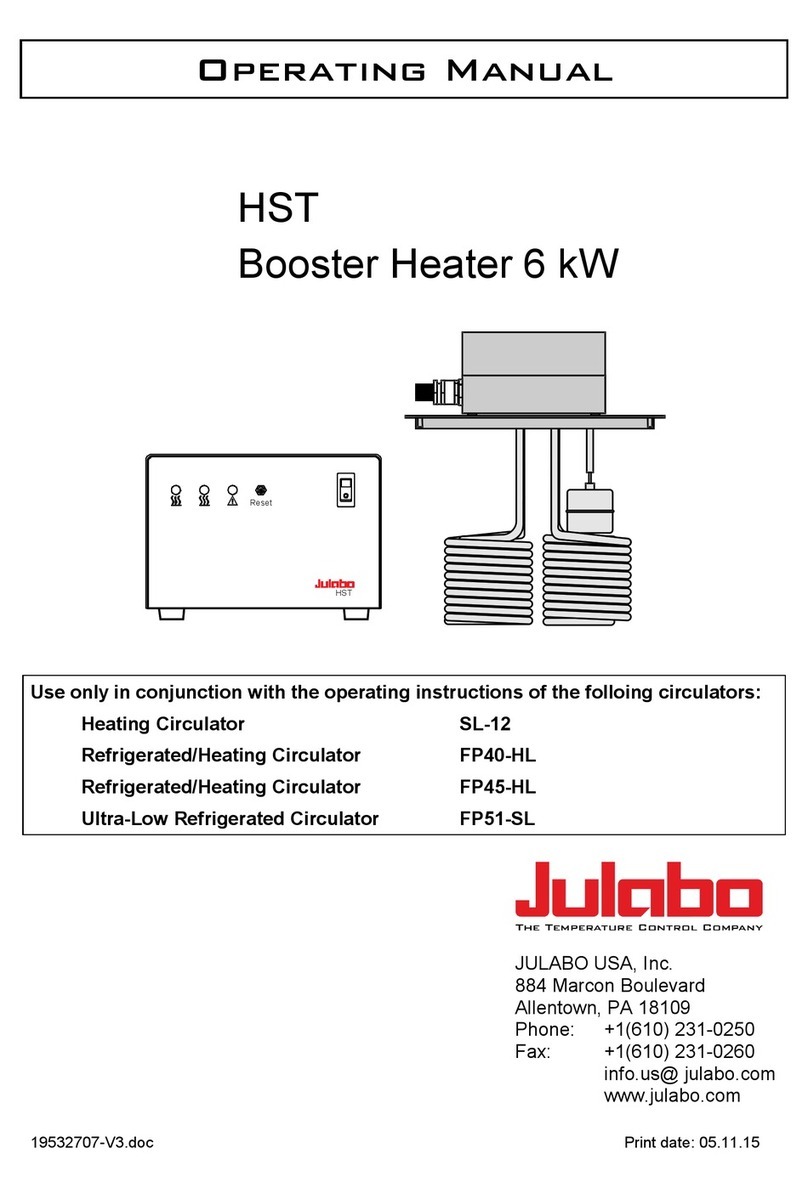
Julabo
Julabo HST operating manual
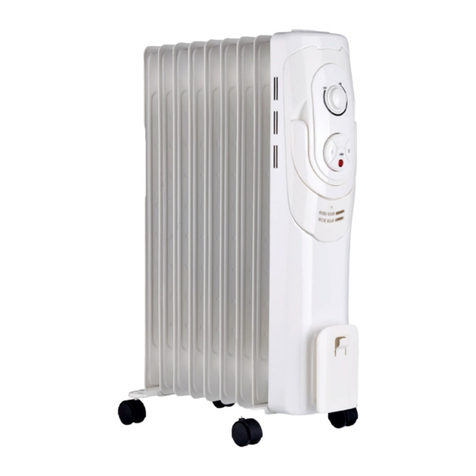
Haverland
Haverland HAT Instruction & installation manual
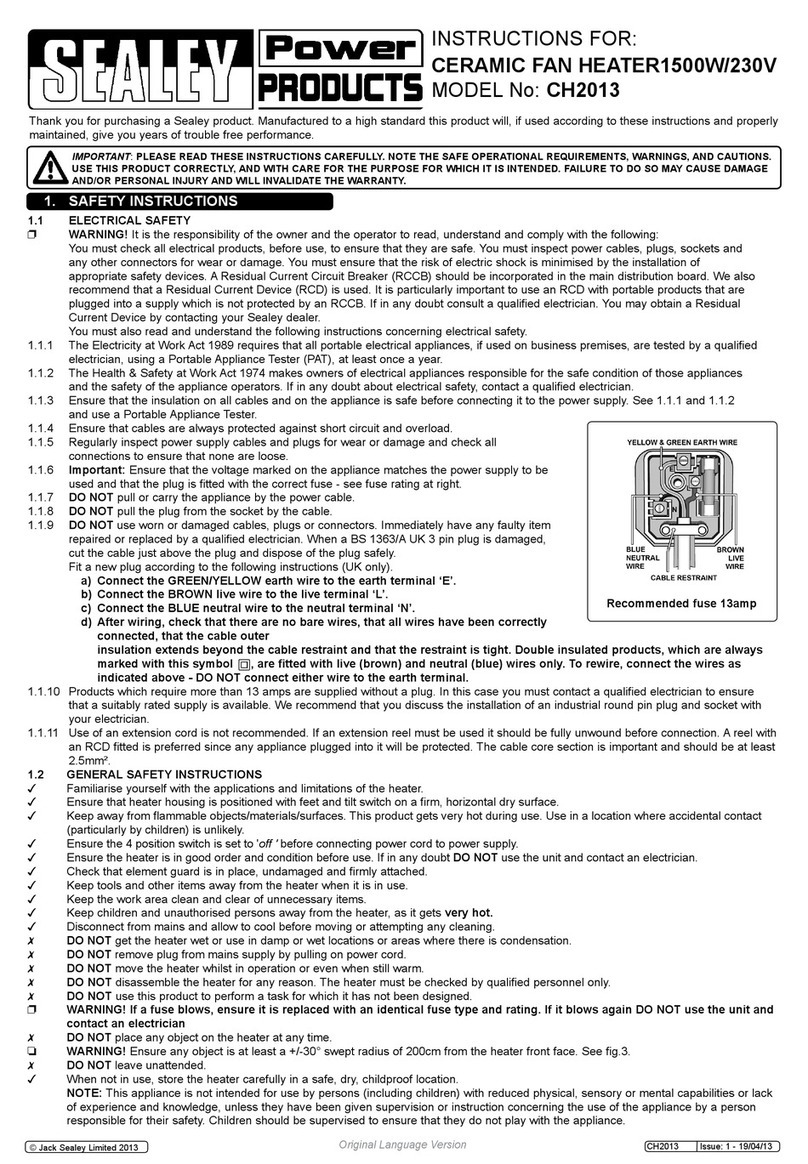
Sealey
Sealey CH2013 instructions
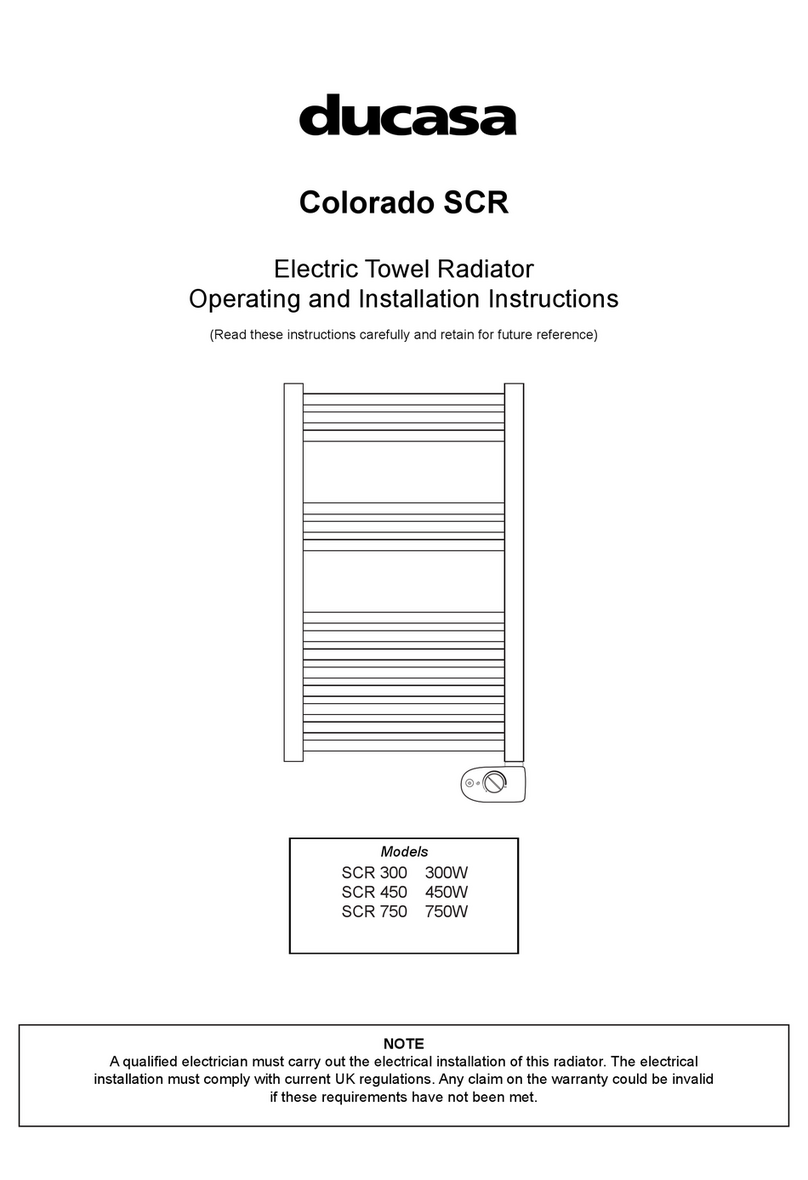
Ducasa
Ducasa Colorado SCR Series Operating and installation instructions
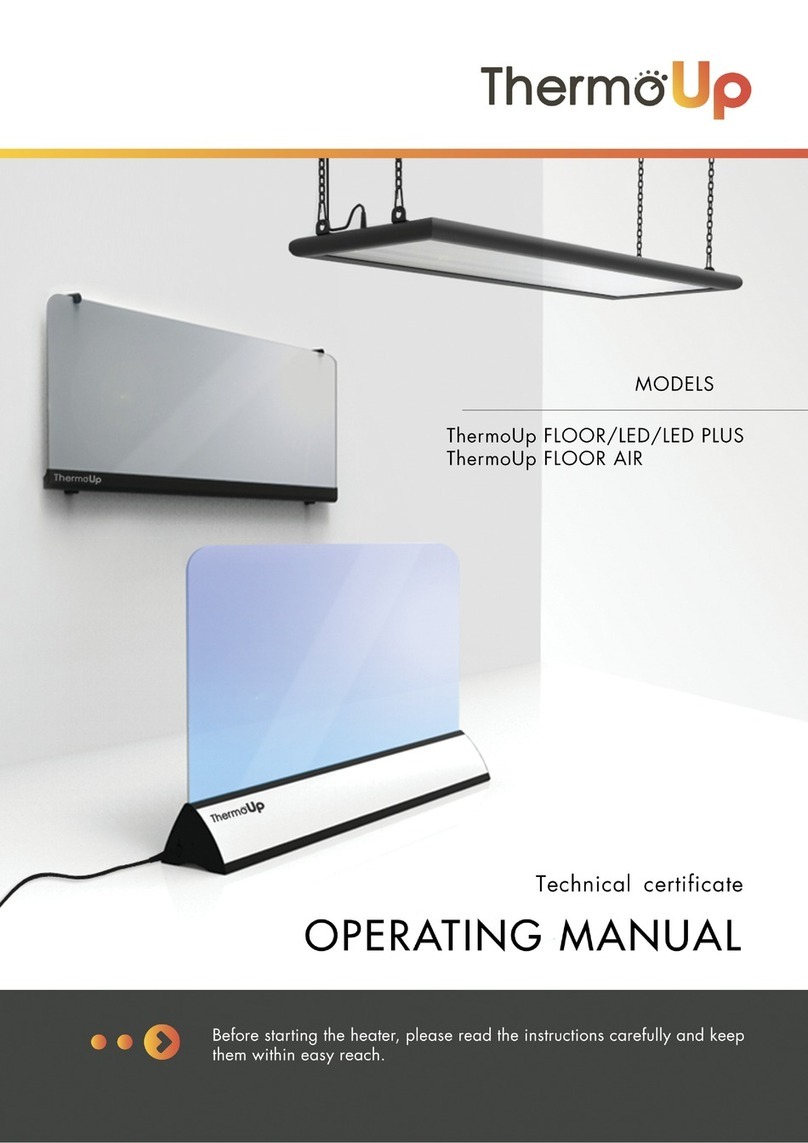
ThermoUp
ThermoUp LED operating manual

Uberhaus
Uberhaus HO-0221 owner's manual
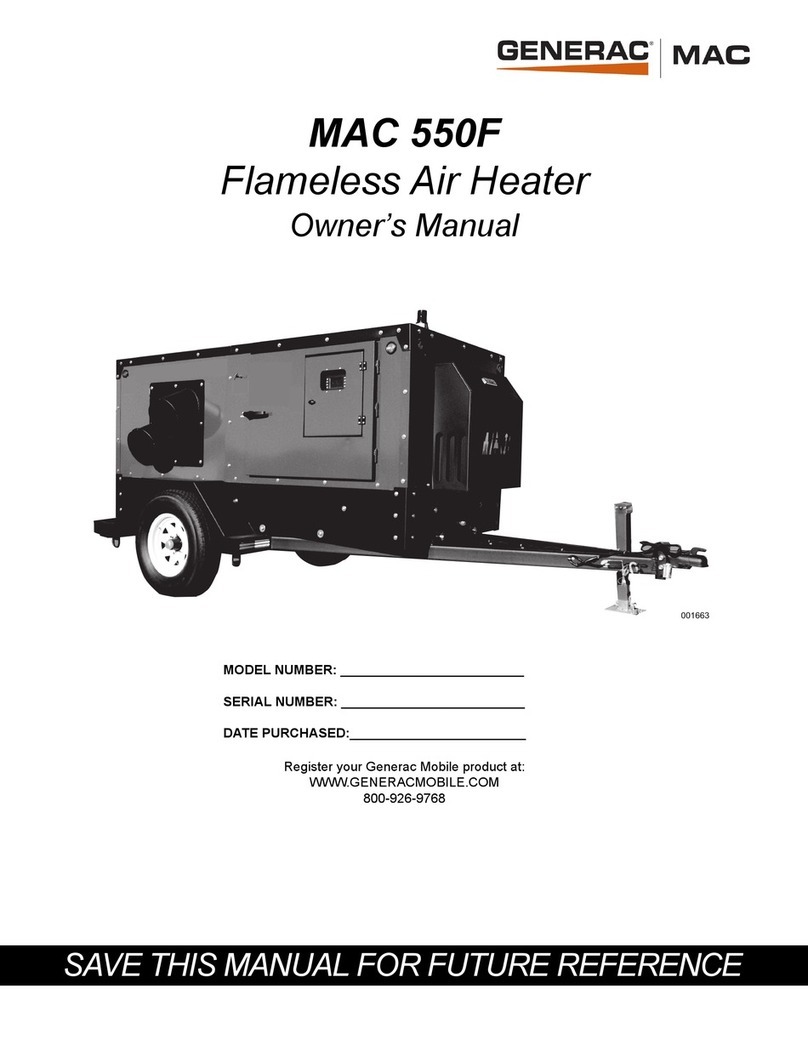
Generac Power Systems
Generac Power Systems MAC 550F owner's manual
